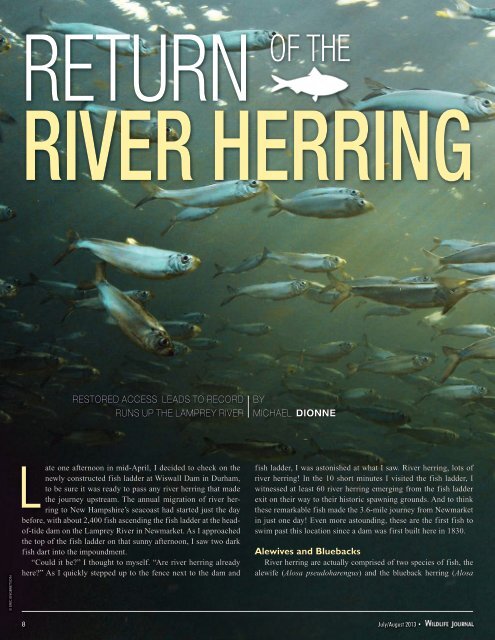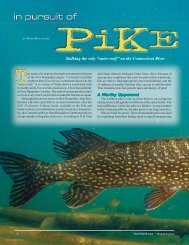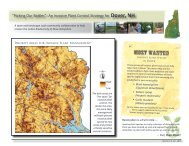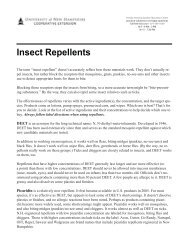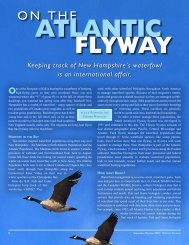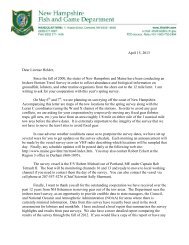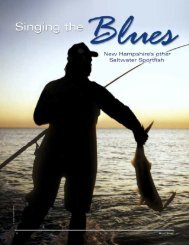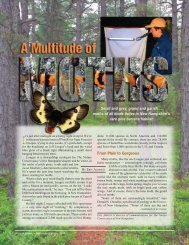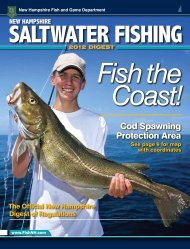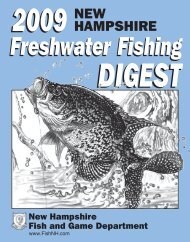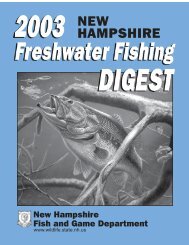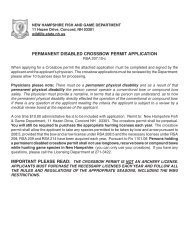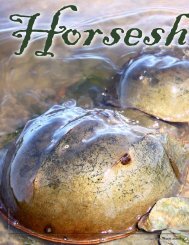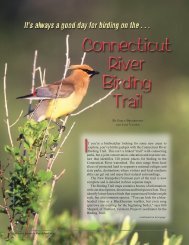Return of the River Herring - New Hampshire Fish and Game ...
Return of the River Herring - New Hampshire Fish and Game ...
Return of the River Herring - New Hampshire Fish and Game ...
Create successful ePaper yourself
Turn your PDF publications into a flip-book with our unique Google optimized e-Paper software.
<strong>Return</strong><br />
<strong>of</strong> <strong>the</strong><br />
<strong>River</strong> <strong>Herring</strong><br />
Restored access leads to record<br />
runs up <strong>the</strong> Lamprey <strong>River</strong><br />
BY<br />
Michael Dionne<br />
© ERIC ENGBRETSON<br />
Late one afternoon in mid-April, I decided to check on <strong>the</strong><br />
newly constructed fish ladder at Wiswall Dam in Durham,<br />
to be sure it was ready to pass any river herring that made<br />
<strong>the</strong> journey upstream. The annual migration <strong>of</strong> river herring<br />
to <strong>New</strong> <strong>Hampshire</strong>’s seacoast had started just <strong>the</strong> day<br />
before, with about 2,400 fish ascending <strong>the</strong> fish ladder at <strong>the</strong> head<strong>of</strong>-tide<br />
dam on <strong>the</strong> Lamprey <strong>River</strong> in <strong>New</strong>market. As I approached<br />
<strong>the</strong> top <strong>of</strong> <strong>the</strong> fish ladder on that sunny afternoon, I saw two dark<br />
fish dart into <strong>the</strong> impoundment.<br />
“Could it be?” I thought to myself. “Are river herring already<br />
here?” As I quickly stepped up to <strong>the</strong> fence next to <strong>the</strong> dam <strong>and</strong><br />
fish ladder, I was astonished at what I saw. <strong>River</strong> herring, lots <strong>of</strong><br />
river herring! In <strong>the</strong> 10 short minutes I visited <strong>the</strong> fish ladder, I<br />
witnessed at least 60 river herring emerging from <strong>the</strong> fish ladder<br />
exit on <strong>the</strong>ir way to <strong>the</strong>ir historic spawning grounds. And to think<br />
<strong>the</strong>se remarkable fish made <strong>the</strong> 3.6-mile journey from <strong>New</strong>market<br />
in just one day! Even more astounding, <strong>the</strong>se are <strong>the</strong> first fish to<br />
swim past this location since a dam was first built here in 1830.<br />
Alewives <strong>and</strong> Bluebacks<br />
<strong>River</strong> herring are actually comprised <strong>of</strong> two species <strong>of</strong> fish, <strong>the</strong><br />
alewife (Alosa pseudoharengus) <strong>and</strong> <strong>the</strong> blueback herring (Alosa<br />
8 July/August 2013 •
aestivalis). The appearance <strong>and</strong> life history <strong>of</strong> <strong>the</strong>se two species<br />
are so similar that we group <strong>the</strong>m toge<strong>the</strong>r as “river herring” <strong>and</strong><br />
manage <strong>the</strong>m as one species.<br />
<strong>River</strong> herring serve as a significant bait source for many commercial<br />
<strong>and</strong> recreational fisheries, such as striped bass, bluefish,<br />
American lobster, Atlantic cod, haddock, <strong>and</strong>, while in freshwater,<br />
large <strong>and</strong> smallmouth bass <strong>and</strong> pickerel, to name a few! They are<br />
anadromous fish, meaning <strong>the</strong>y spend most <strong>of</strong> <strong>the</strong>ir life in <strong>the</strong><br />
ocean, but must migrate into freshwater to spawn.<br />
After spawning, which happens from early May to mid-June,<br />
<strong>the</strong> adults quickly move back downriver <strong>and</strong> into <strong>the</strong> estuary,<br />
while <strong>the</strong> juveniles spend <strong>the</strong> remainder <strong>of</strong> spring <strong>and</strong> a good<br />
portion <strong>of</strong> <strong>the</strong> summer in freshwater, feeding <strong>and</strong> growing.<br />
Emigration, or <strong>the</strong> seaward migration <strong>of</strong> juvenile river herring,<br />
is usually initiated by an increase in river flows following heavy<br />
rain sometime in late summer or early fall. The juvenile river herring<br />
school toge<strong>the</strong>r in <strong>the</strong> ocean <strong>and</strong> feed primarily on plankton.<br />
They generally return back to <strong>New</strong> <strong>Hampshire</strong>’s coastal rivers by<br />
<strong>the</strong> age <strong>of</strong> four or five to spawn. Typically, <strong>the</strong>y return each year<br />
until <strong>the</strong>y are six or seven years old, but we have seen some fish<br />
as old as nine returning to spawn.<br />
Alewives <strong>and</strong> blueback herring are both considered species<br />
• July/August 2013 9<br />
• July/August 2013 9
Alewife<br />
Blueback herring<br />
American shad<br />
<strong>of</strong> concern by NOAA’s (National Oceanic <strong>and</strong> Atmospheric<br />
Administration) National Marine <strong>Fish</strong>eries Service (NMFS) <strong>and</strong><br />
by <strong>the</strong> State <strong>of</strong> <strong>New</strong> <strong>Hampshire</strong>. Both species range up <strong>and</strong> down<br />
<strong>the</strong> entire Atlantic coast, <strong>and</strong> numbers returning to rivers each<br />
spring are at all-time lows. Even here in <strong>New</strong> <strong>Hampshire</strong>, we<br />
have seen coastal returns <strong>of</strong> nearly 200,000 fish as recently as<br />
2003 diminish to just about 35,000 fish making <strong>the</strong>ir way up <strong>the</strong><br />
rivers in 2006.<br />
Fortunately, N.H. coastal rivers have slowly rebounded, with<br />
117,000 adult river herring returning to spawn in 2012. Most <strong>of</strong><br />
<strong>the</strong> recovery in recent years in N.H. can be attributed to <strong>the</strong> health<br />
<strong>and</strong> resilience <strong>of</strong> <strong>the</strong> river herring run in <strong>the</strong> Lamprey <strong>River</strong>.<br />
Monitoring <strong>the</strong> Migration<br />
Each spring, <strong>Fish</strong> <strong>and</strong> <strong>Game</strong>'s Marine <strong>Fish</strong>eries Division monitors<br />
seven fish passage structures on six different coastal rivers.<br />
Typically, river herring first return to <strong>the</strong> Lamprey <strong>River</strong> during <strong>the</strong><br />
second or third week <strong>of</strong> April. The barrier <strong>the</strong>y first encounter is <strong>the</strong><br />
Macallen Dam in <strong>New</strong>market, built in 1887. A remnant population<br />
<strong>of</strong> river herring has survived, spawning in <strong>the</strong> lower salinity just<br />
below <strong>the</strong> falls.<br />
Around 1971, <strong>Fish</strong> <strong>and</strong> <strong>Game</strong> built a Denil fish ladder at Macallen<br />
MOVING UPSTREAM<br />
In mid to late April, river herring begin <strong>the</strong>ir trek up <strong>the</strong> Lamprey <strong>River</strong>. Once a barrier to herring<br />
migration, NORTHWOOD <strong>the</strong> Macallen Dam, is overcome BARRINGTON<br />
via a fish ladder built in 1971. From this point, <strong>the</strong><br />
herring continue upstream 3.6 miles to <strong>the</strong> Wiswall Dam. Until recently, this was <strong>the</strong> end <strong>of</strong><br />
<strong>the</strong>ir migration, but in 2012 a fish ladder was constructed, giving <strong>the</strong> fish access to ano<strong>the</strong>r 7.8<br />
miles upstream to Wadleigh Falls. Here, <strong>the</strong> herring seem unable to pass, as <strong>the</strong>y are not able to<br />
"jump" <strong>the</strong> falls as salmon would. Beyond this point, 12.5 miles upstream, <strong>the</strong> Bunker Pond Dam<br />
was removed in 2011; eventually, this will allow passage to an additional 27 miles <strong>of</strong> <strong>the</strong> river.<br />
DEERFIELD<br />
NOTTINGHAM<br />
Wiswall Dam<br />
LEE<br />
DURHAM<br />
NEWINGTON<br />
L A M P R E Y<br />
R<br />
I V E R<br />
RAYMOND<br />
Wadleigh Falls<br />
EPPING<br />
L A M P R E Y<br />
R I V E R<br />
NEWMARKET<br />
NEWFIELDS<br />
GREAT<br />
BAY<br />
GREENLAND<br />
PORTSMOUTH<br />
RYE<br />
FREMONT<br />
BRENTWOOD<br />
EXETER<br />
Bunker Pond Dam<br />
(removed)<br />
Macallen Dam<br />
10 July/August 2013 •<br />
ATLANTIC<br />
OCEAN
MONITORING RIVER HERRING<br />
© nhfg STAFF photoS<br />
Clockwise from top left: <strong>River</strong> herring are collected by biologists<br />
with a seining net for sampling; after <strong>the</strong>y are netted, <strong>the</strong> fish are<br />
quickly measured; marine biologist Renee Zobel takes a scale<br />
sample for data collection; a fish-eye view <strong>of</strong> a fish ladder.<br />
Dam, <strong>and</strong> over 1.3 million river herring have migrated through <strong>the</strong><br />
ladder over <strong>the</strong> last 41 years! The fish ladder benefits not only river<br />
herring, but o<strong>the</strong>r anadromous fish such as sea lamprey <strong>and</strong> a small<br />
number <strong>of</strong> American shad. Also, some <strong>of</strong> <strong>the</strong> stronger-swimming<br />
resident species like trout, smallmouth bass <strong>and</strong> common white<br />
sucker use <strong>the</strong> fish ladder to gain access back to freshwater after<br />
inadvertently finding <strong>the</strong>ir way to <strong>the</strong> saltwater below <strong>the</strong> dam.<br />
In 2012, a record return <strong>of</strong> 86,862 river herring returned to <strong>the</strong><br />
fish ladder at Macallen Dam. This exceeded <strong>the</strong> previous return<br />
record <strong>of</strong> 66,333 fish in 2004, <strong>and</strong> far exceeded <strong>the</strong> average annual<br />
return <strong>of</strong> about 32,000 river herring.<br />
In recent years, <strong>the</strong> Lamprey <strong>River</strong> has withstood extreme conditions,<br />
from flooding to drought, better than o<strong>the</strong>r coastal rivers,<br />
<strong>and</strong> continues to have some <strong>of</strong> our most consistent returns. These<br />
strong return numbers at <strong>the</strong> Lamprey allow <strong>Fish</strong> <strong>and</strong> <strong>Game</strong> to utilize<br />
river herring from <strong>the</strong> river to restore o<strong>the</strong>r depleted runs in <strong>New</strong><br />
<strong>Hampshire</strong>. Each spring, a small portion <strong>of</strong> returning river herring<br />
are trapped at <strong>the</strong> fish ladder in <strong>New</strong>market <strong>and</strong> trucked to o<strong>the</strong>r<br />
coastal rivers as needed; some are also transported to <strong>the</strong> Merrimack<br />
<strong>River</strong> to try to “jump start” depleted runs <strong>of</strong> fish.<br />
Moving Up <strong>River</strong><br />
After passing <strong>the</strong> fish ladder at Macallen Dam in <strong>New</strong>market, <strong>the</strong><br />
river herring maneuver <strong>the</strong>ir way through <strong>the</strong> impounded backwater,<br />
up through Packer’s Falls to Wiswall Dam, a distance <strong>of</strong> 3.6 miles,<br />
with many turns, coves <strong>and</strong> even an ancient oxbow to navigate. Until<br />
2012, this is where <strong>the</strong>ir journey stopped; all returning river herring<br />
spawned here. However, <strong>the</strong> new fish ladder at Wiswall Dam now<br />
allows river herring to access nearly eight miles <strong>of</strong> historic spawning<br />
habitat above <strong>the</strong> dam for <strong>the</strong> first time since 1830.<br />
The new fish ladder at Wiswall Dam was a long time in <strong>the</strong> making.<br />
<strong>Fish</strong> <strong>and</strong> <strong>Game</strong> initiated <strong>the</strong> project back in 2000. The project<br />
• July/August 2013 11
"The future for<br />
river herring in <strong>the</strong><br />
Lamprey <strong>River</strong><br />
watershed looks<br />
very bright."<br />
© ethan gordon<br />
went through many iterations, from a nature-like dam bypass channel<br />
to complete dam removal, before fizzling out. Then in 2008,<br />
<strong>the</strong> dam owner, <strong>the</strong> Town <strong>of</strong> Durham, <strong>and</strong> <strong>the</strong> Natural Resource<br />
Conservation Service (NRCS) teamed up to build a fish ladder<br />
at <strong>the</strong> site. Many state <strong>and</strong> government agencies collaborated on<br />
<strong>the</strong> fish ladder project, which was finally completed in January<br />
<strong>of</strong> 2012. The fish ladder is owned <strong>and</strong> operated by <strong>the</strong> Town <strong>of</strong><br />
Durham, with technical guidance provided by <strong>Fish</strong> <strong>and</strong> <strong>Game</strong><br />
Marine <strong>Fish</strong>eries staff. A volunteer fish count coordinated by <strong>Fish</strong><br />
<strong>and</strong> <strong>Game</strong> <strong>and</strong> <strong>the</strong> Town <strong>of</strong> Durham estimated that 31,888 river<br />
herring made <strong>the</strong>ir way through <strong>the</strong> new fish ladder at Wiswall<br />
Dam in 2012. That is an impressive number <strong>of</strong> fish passing through<br />
during its first year <strong>of</strong> operation!<br />
From Wiswall Dam, <strong>the</strong> river herring travel 7.8 miles to<br />
Wadleigh Falls in Lee. Wadleigh Falls is a historic mill site with a<br />
partially breached dam. The dam breach sits on a substantial ledge<br />
that can be very difficult for herring to ascend. Unlike salmon <strong>and</strong><br />
trout, river herring cannot “jump” or “leap” over obstacles in a river<br />
12 July/August 2013 •
during migration. <strong>River</strong> herring must continuously swim within<br />
<strong>the</strong> column <strong>of</strong> water to make <strong>the</strong>ir way up <strong>and</strong> over obstacles. This<br />
can make passage over some barriers very difficult from year to<br />
year as river flow varies; if flows are too low or too high or fast, <strong>the</strong><br />
fish simply cannot make it.<br />
In 2012, <strong>Fish</strong> <strong>and</strong> <strong>Game</strong> staff observed thous<strong>and</strong>s <strong>of</strong> river herring<br />
below Wadleigh Falls attempting to pass, but during limited<br />
observations, no passage was confirmed. More information should<br />
be forthcoming from a radio-tagging study <strong>of</strong> river herring in <strong>the</strong><br />
Lamprey conducted by Marine Division staff this spring to determine<br />
<strong>the</strong> extent <strong>of</strong> upstream migration.<br />
The National Wild <strong>and</strong> Scenic <strong>River</strong>s System was created<br />
to preserve certain rivers with outst<strong>and</strong>ing natural, cultural<br />
<strong>and</strong> recreational values in a free-flowing condition for<br />
<strong>the</strong> enjoyment <strong>of</strong> present <strong>and</strong> future generations. This<br />
designation safeguards <strong>the</strong> special character <strong>of</strong> <strong>the</strong><br />
Lamprey <strong>River</strong> while recognizing <strong>the</strong> need for appropriate<br />
use <strong>and</strong> development – an invaluable asset to <strong>the</strong> protection <strong>of</strong> one <strong>of</strong> <strong>the</strong><br />
largest, most rural <strong>and</strong> healthy rivers that enters Great Bay.<br />
Free-flowing Habitat<br />
Beyond Wadleigh Falls, ano<strong>the</strong>r 12.5 miles upstream is <strong>the</strong> former<br />
Bunker Pond Dam site in Epping. A dam had existed at this<br />
location on <strong>the</strong> Lamprey <strong>River</strong> since 1746, when an impoundment<br />
was created to power a grist mill, <strong>and</strong> later, around 1876, <strong>the</strong> Folsom<br />
sawmill <strong>and</strong> box factory. The Town <strong>of</strong> Epping sold <strong>the</strong> dam to <strong>the</strong><br />
State <strong>of</strong> <strong>New</strong> <strong>Hampshire</strong> in 1959 for $1. In 1964, <strong>Fish</strong> <strong>and</strong> <strong>Game</strong><br />
discussed <strong>the</strong> idea <strong>of</strong> installing a fish ladder at <strong>the</strong> dam, but instead a<br />
15-foot high concrete spillway with a low-level gate was constructed<br />
in 1966-1967, without any fish passage structure.<br />
The Bunker Pond Dam was removed by N.H. Department <strong>of</strong><br />
Environmental Services crews in 2011. The dam was a low-hazard<br />
structure, but <strong>the</strong> area impounded by <strong>the</strong> dam was very prone to<br />
flooding. With large flood events becoming more common in recent<br />
years, dam safety specifications have become tougher. The Bunker<br />
Pond Dam did not meet <strong>the</strong> current safety st<strong>and</strong>ards, <strong>and</strong> it was<br />
cheaper to remove it than build a new structure. In addition, federal<br />
grant money was available to help fund dam removal projects <strong>and</strong><br />
restore aquatic habitats.<br />
Ano<strong>the</strong>r goal <strong>of</strong> removing Bunker Pond Dam was to open up <strong>the</strong><br />
Lamprey <strong>River</strong> to a free-flowing condition. Dams block <strong>the</strong> flow <strong>of</strong><br />
sediments <strong>and</strong> nutrients in rivers. This can starve <strong>the</strong> downstream<br />
side <strong>of</strong> <strong>the</strong> dam <strong>of</strong> vital nutrients. Conversely, <strong>the</strong> impoundment<br />
behind <strong>the</strong> dam can become too nutrient-rich. This causes an overabundance<br />
<strong>of</strong> plant life <strong>and</strong> algae, which can significantly reduce<br />
dissolved oxygen levels, potentially affecting fish <strong>and</strong> o<strong>the</strong>r aquatic<br />
life. Also, <strong>the</strong> reduced river flow <strong>and</strong> increased surface area <strong>of</strong> an<br />
impoundment absorbs heat from <strong>the</strong> sun, elevating water temperatures.<br />
Warmer water contains less dissolved oxygen. Removal <strong>of</strong> <strong>the</strong><br />
barrier (dam) allows for better nutrient exchange, which improves<br />
<strong>the</strong> water quality <strong>and</strong> allows for free movement <strong>of</strong> aquatic species.<br />
An additional 27 miles <strong>of</strong> <strong>the</strong> Lamprey <strong>River</strong> <strong>and</strong> its tributaries lie<br />
above <strong>the</strong> former Bunker Pond dam location.<br />
Wild <strong>and</strong> Scenic Resource<br />
The Lamprey <strong>River</strong> was designated as a Wild <strong>and</strong> Scenic <strong>River</strong> by<br />
<strong>the</strong> National Park Service in 1996. The designation begins at <strong>the</strong> confluence<br />
with <strong>the</strong> Piscassic <strong>River</strong> in <strong>New</strong>market <strong>and</strong> ends at <strong>the</strong> former<br />
Bunker Pond Dam site. Now that <strong>the</strong> dam is gone, this protective status<br />
may eventually be extended to <strong>the</strong> upper reaches <strong>of</strong> <strong>the</strong> watershed.<br />
With <strong>the</strong> removal <strong>of</strong> Bunker Pond Dam, designation as a Wild<br />
<strong>and</strong> Scenic <strong>River</strong>, <strong>and</strong> <strong>the</strong> new fish ladder at Wiswall Dam opening<br />
© Jerry MONKMAN<br />
Scenic Packer's Falls, Lamprey <strong>River</strong>, Durham<br />
up almost eight miles <strong>of</strong> spawning habitat, <strong>the</strong> future for river<br />
herring in <strong>the</strong> Lamprey <strong>River</strong> watershed looks bright. If river<br />
herring could get past Wadleigh Falls, a total <strong>of</strong> 70 miles <strong>of</strong> main<br />
stem <strong>and</strong> tributaries <strong>of</strong> <strong>the</strong> Lamprey <strong>River</strong> would be available to<br />
to <strong>the</strong>m for spawning. The potential exists that <strong>New</strong> <strong>Hampshire</strong>'s<br />
very own Lamprey <strong>River</strong> could be home to one <strong>of</strong> <strong>the</strong> strongest<br />
river herring runs on <strong>the</strong> entire Atlantic Coast.<br />
Michael Dionne is a Marine Biologist in N.H. <strong>Fish</strong> <strong>and</strong> <strong>Game</strong>'s<br />
Marine <strong>Fish</strong>eries Division.<br />
• July/August 2013 13


